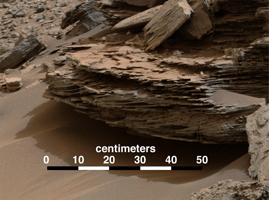
Figure 1
Click on the image for larger versionThis view from the Mast Camera (Mastcam) on NASA's Mars rover Curiosity shows an example of cross-bedding that results from water passing over a loose bed of sediment.
The cross-bedding -- evident as layers at angles to each other -- reflects formation and passage of waves of sand, one on top of the other. These are known as ripples, or dunes. The direction of migration of these small ripples and dunes was toward the southeast. That direction is toward Mount Sharp and away from the area where Curiosity found evidence of delta deposits where a stream entered a lake. The directional flows recorded in the sediments are interpreted to have formed by currents moving down the deltas and into deeper lake water.
The color has been approximately white-balanced to resemble how the scene would appear under daytime lighting conditions on Earth. Figure 1 is a cropped version with a superimposed scale bar of 50 centimeters (about 20 inches) just beneath the cross-bedding.
The Mastcam's right-eye camera captured the component frames of this mosaic image at a target called "Whale Rock" during the 796th Martian day, or sol, of the rover's work on Mars (Nov. 2, 2014). The location of Whale Rock within the "Pahrump Hills" outcrop at the base of Mount Sharp is indicated on an earlier Mastcam view at PIA19039.
NASA's Jet Propulsion Laboratory, a division of the California Institute of Technology, Pasadena, manages the Mars Science Laboratory Project for NASA's Science Mission Directorate, Washington. JPL designed and built the project's Curiosity rover. Malin Space Science Systems, San Diego, built and operates the rover's Mastcam.
More information about Curiosity is online at http://www.nasa.gov/msl and http://mars.jpl.nasa.gov/msl/.

